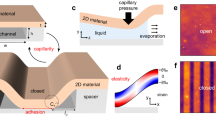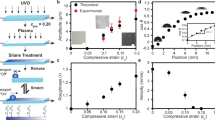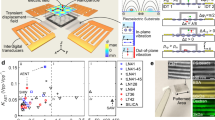Abstract
Fluidic transport through nanochannels offers new opportunities to probe fundamental nanoscale transport phenomena1,2,3,4,5 and to develop tools for manipulating DNA6,7,8,9,10,11,12,13,14,15,16, proteins17,18, small molecules19,20 and nanoparticles21,22. The small size of nanofabricated devices and the accompanying increase in the effect of surface forces23,24, however, pose challenges in designing and fabricating flexible nanofluidic systems that can dynamically adjust their transport characteristics according to the handling needs of various molecules and nanoparticles. Here, we describe the use of nanoscale fracturing of oxidized poly(dimethylsiloxane) to conveniently fabricate nanofluidic systems with arrays of nanochannels that can actively manipulate nanofluidic transport through dynamic modulation of the channel cross-section. We present the design parameters for engineering material properties and channel geometry to achieve reversible nanochannel deformation using remarkably small forces. We demonstrate the versatility of the elastomeric nanochannels through tuneable sieving and trapping of nanoparticles, dynamic manipulation of the conformation of single DNA molecules and in situ photofabrication of movable polymeric nanostructures.
This is a preview of subscription content, access via your institution
Access options
Subscribe to this journal
Receive 12 print issues and online access
$259.00 per year
only $21.58 per issue
Buy this article
- Purchase on Springer Link
- Instant access to full article PDF
Prices may be subject to local taxes which are calculated during checkout




Similar content being viewed by others
References
Chen, J. Y., Kutana, A., Collier, C. P. & Giapis, K. P. Electrowetting in carbon nanotubes. Science 310, 1480–1483 (2005).
Pennathur, S. & Santiago, J. G. Electrokinetic transport in nanochannels. 2. Experiments. Anal. Chem. 77, 6782–6789 (2005).
Pu, Q., Yun, J., Temkin, H. & Liu, S. Ion-enrichment and ion-depletion effect of nanochannel structures. Nano Lett. 4, 1099–1103 (2004).
Eijkel, J. C. T., Bomer, J. G. & van den Berg, A. Osmosis and pervaporation in polyimide submicron microfluidic channel structures. Appl. Phys. Lett. 87, 114103 (2005).
Garcia, A. L. et al. Electrokinetic molecular separation in nanoscale fluidic channels. Lab Chip 5, 1271–1276 (2005).
Han, J. & Craighead, H. G. Separation of long DNA molecules in a microfabricated entropic trap array. Science 288, 1026–1029 (2000).
Reccius, C. H., Mannion, J. T., Cross, J. D. & Craighead, H. G. Compression and free expansion of single DNA molecules in nanochannels. Phys. Rev. Lett. 95, 268101 (2005).
Tegenfeldt, J. O. et al. The dynamics of genomic-length DNA molecules in 100-nm channels. Proc. Natl Acad. Sci. USA 101, 10979–10983 (2004).
Guo, L. J., Cheng, X. & Chou, C.-F. Fabrication of size-controllable nanofluidic channels by nanoimprinting and its application for DNA stretching. Nano Lett. 4, 69–73 (2004).
Foquet, M., Korlach, J., Zipfel, W., Webb, W. W. & Craighead, H. G. DNA fragment sizing by single molecule detection in submicrometer-sized closed fluidic channels. Anal. Chem. 74, 1415–1422 (2002).
Campbell, L. C., Wilkinson, M. J., Manz, A., Camilleri, P. & Humphreys, C. J. Electrophoretic manipulation of single DNA molecules in nanofabricated capillaries. Lab Chip 4, 225–229 (2004).
Reisner, W. et al. Statics and dynamics of single DNA molecules confined in nanochannels. Phys. Rev. Lett. 94, 196101 (2005).
Fu, J. P., Schoch, R. B., Stevens, A. L., Tannenbaum, S. R. & Han, J. Y. A patterned anisotropic nanofluidic sieving structure for continuous-flow separation of DNA and proteins. Nature Nanotech. 2, 121–128 (2007).
Craighead, H. G. Future lab-on-a-chip technologies for interrogating individual molecules. Nature 442, 387–393 (2006).
Riehn, R., Austin, R. H. & Sturm, J. C. A nanofluidic railroad switch for DNA. Nano Lett. 6, 1973–1976 (2006).
Riehn, R. et al. Restriction mapping in nanofluidic devices. Proc. Natl Acad. Sci. USA 102, 10012–10016 (2005).
Wang, Y.-C., Stevens, A. L. & Han, J. Million-fold preconcentration of proteins and peptides by nanofluidic filter. Anal. Chem. 77, 4293–4299 (2005).
Sivanesan, P., Okamoto, K., English, D., Lee, C. S. & DeVoe, D. L. Polymer nanochannels fabricated by thermomechanical deformation for single-molecule analysis. Anal. Chem. 77, 2252–2258 (2005).
Jirage, K. B., Hulteen, J. C. & Martin, C. R. Nanotubule-based molecular filtration membranes. Science 278, 655–658 (1997).
Lee, S. B. et al. Antibody-based bio-nanotube membranes for enantiomeric drug separations. Science 296, 2198–2200 (2002).
Stavis, S. M., Edel, J. B., Samiee, K. T. & Craighead, H. G. Single molecule studies of quantum dot conjugates in a submicrometer fluidic channel. Lab Chip 5, 337–343 (2005).
Drazer, G., Koplik, J. & Acrivos, A. Absorption phenomena in the transport of a colloidal particle through a nanochannel containing a partially wetting fluid. Phys. Rev. Lett. 89, 244501 (2002).
Huang, Y. G. Y. et al. Stamp collapse in soft lithography. Langmuir 21, 8058–8068 (2005).
Hui, C. Y., Jagota, A., Lin, Y. Y. & Kramer, E. J. Constraints on microcontact printing imposed by stamp deformation. Langmuir 18, 1394–1407 (2002).
Zhu, X. Y. et al. Fabrication of reconfigurable protein matrices by cracking. Nature Mater. 4, 403–406 (2005).
Bowden, N., Huck, W. T. S., Paul, K. E. & Whitesides, G. M. The controlled formation of ordered, sinusoidal structures by plasma oxidation of an elastomeric polymer. Appl. Phys. Lett. 75, 2557–2559 (1999).
Schmid, H. & Michel, B. Siloxane polymers for high-resolution, high-accuracy soft lithography. Macromolecules 33, 3042–3049 (2000).
Odom, T. W., Love, J. C., Wolfe, D. B., Paul, K. E. & Whitesides, G. M. Improved pattern transfer in soft lithography using composite stamps. Langmuir 18, 5314–5320 (2002).
Decre, M. M. J., Timmermans, P. H. M., Sluis, O. & Schroeders, R. Numerical and experimental study of critical roof collapse conditions in soft lithography. Langmuir 21, 7971–7978 (2005).
Beebe, D. J. et al. Functional hydrogel structures for autonomous flow control inside microfluidic channels. Nature 404, 588–590 (2000).
Acknowledgements
We thank M. Mayer for comments on the manuscript, N. Futai for assistance in electrical resistance measurements, J. H. Bahng for help with channel fabrication and K. E. Sung for preparing DNA samples. We thank K. Naruse for the mechanical stretcher device. This work was supported by NSF, NIH and the NASA BioScience and Engineering Institute. D.H. acknowledges a Horace H. Rackham Predoctoral Fellowship from the University of Michigan.
Author information
Authors and Affiliations
Contributions
D.H. designed and fabricated the nanochannel systems, carried out the experiments, analysed the data and wrote the manuscript. K.L.M. conducted numerical simulations of nanochannel closure and helped to write the paragraphs describing the simulation results. X.Y.Z. helped to take AFM measurements of nanochannel cross-sections. M.A.B. helped to plan DNA stretching experiments and provided DNA samples. M.D.T. helped to design the simulation studies, interpreted simulation results and edited the manuscript. S.T. designed the project and edited the manuscript. All authors commented on the manuscript.
Corresponding author
Ethics declarations
Competing interests
The authors declare no competing financial interests.
Supplementary information
Supplementary Information
Supplementary methods and supplementary figures 1-6 (PDF 1040 kb)
Rights and permissions
About this article
Cite this article
Huh, D., Mills, K., Zhu, X. et al. Tuneable elastomeric nanochannels for nanofluidic manipulation. Nature Mater 6, 424–428 (2007). https://doi.org/10.1038/nmat1907
Received:
Accepted:
Published:
Issue Date:
DOI: https://doi.org/10.1038/nmat1907
This article is cited by
-
High-force, precise, and bidirectional uniaxial stretcher for real-time imaging of normally closed h-PDMS crack-valves for femto-liter fluid delivery
Microfluidics and Nanofluidics (2022)
-
Effects of Corona Treatment on Cellular Attachment and Morphology on Polydimethylsiloxane Micropillar Substrates
JOM (2022)
-
Regional and functional division of functional elements of solid-state nanochannels for enhanced sensitivity and specificity of biosensing in complex matrices
Nature Protocols (2021)
-
Dimension-reconfigurable bubble film nanochannel for wetting based sensing
Nature Communications (2020)
-
Nanoelectrokinetic Selective Preconcentration Based on Ion Concentration Polarization
BioChip Journal (2020)



